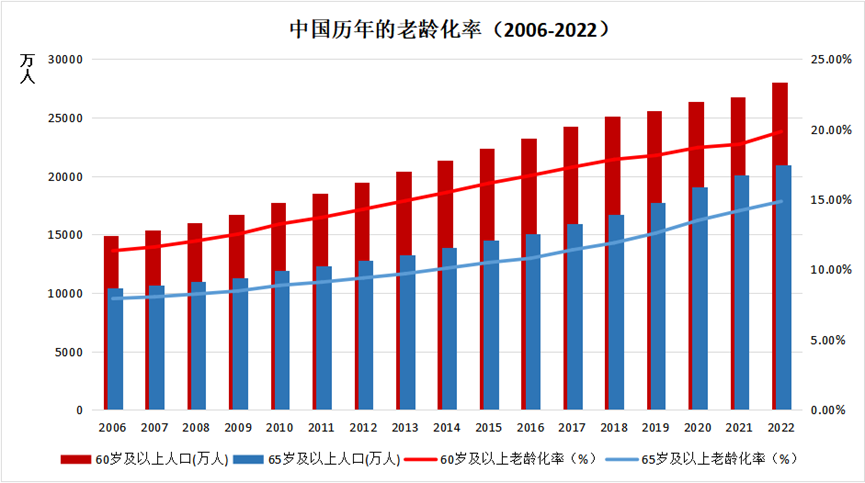China’s Aging Issues And Development Prospects – Analysis
By Anbound
By He Jun
Among the various data on China’s economic and social development in 2022 published by the country’s National Bureau of Statistics (NBS), the negative population growth has become an issue of concern.
According to NBS data, the national population of Mainland China at the end of 2022 was 1,411.75 million, a decrease of 850,000 compares with the end of last year. Specifically, in 2022, there were 9.56 million births, with a birth rate of 6.77‰; 10.41 million deaths, with a death rate of 7.37‰; and a natural population growth rate of -0.60‰.
This is the first time since the founding of the People’s Republic of China, except for 1960 and 1961, that the country has experienced a trend of negative population growth.
It has been expected that China is entering the stage of negative population growth. On July 21, 2022, Yang Wenzhuang, head of population and family affairs at the National Health Commission, said that the growth rate of the country’s total population has slowed down significantly, and it is expected to enter negative growth during the 14th Five-Year Plan period (2021-2025). In the same year, the World Population Prospects 2022 published by the United Nations predicted that China may experience negative population growth as early as 2023.
China’s rapid decline in the number of births and fertility rates in recent years also heralds the arrival of this day. Some Chinese scholars have calculated based on the data of the Seventh National Population Census that in 2017, the number of births in China was more than 18 million. From 2010 to 2017, it basically fluctuated around this level, but just a few years later, in 2021 The birth population dropped to 10.62 million and further fell below 10 million in 2022. Now, its fertility level has entered the ranks of the lowest in the world. Since 1992, its total fertility rate has been lower than the replacement level of 2.1. The inertia of negative population growth accumulated for more than 30 years manifested as negative population growth in 2022.
Researchers at ANBOUND believe that looking at China’s population issue, it is not just the decline in the population number, but a bigger problem comes from China’s rapid aging. In terms of age composition, the working-age population aged 16-59 in 2022 was 875.56 million, accounting for 62.0%. The population aged 60 and above was 280.04 million, accounting for 19.8%. There are 209.78 million people aged 65 and over, accounting for 14.9% of the national population. As the population born in the 1960s enters the aging stage, China’s aging rate is growing steadily and showing a trend of acceleration.
Figure: China’s Rapid Aging Rate
China’s aging rate is lower than that of Japan, which entered the super-aging stage in 2021, the elderly (65 years and above) in Japan accounted for 29.79% of the total population. However, unlike any country with a high degree of aging, the scale of aging in China is extremely huge. In 2022, China’s population aged 60 and over exceeded 280 million, which is 2.22 times the total population of Japan and 84% of the United States. According to the State Council’s report on aging in September 2022, the total number of elderly people aged 60 and above in China will exceed 300 million during the 14th Five-Year Plan period, accounting for more than 20%. In 2035, the population aged 60 and above will increase to about 420 million, accounting for more than 30%. Wang Jianjun, a member of the party group of the National Health Commission and executive deputy director of the National Office on Aging, said in the past that it is estimated that by around 2050, the number of elderly people aged 60 and above in China will reach a peak of 487 million, accounting for 34.9% of the total population.
At present and in the future, China is facing multiple situations of declining birth rate, a negative growth of the total population, and rapidly deepening aging. It is generally believed that when the proportion of the elderly population aged 60 and above exceeds 20% and 30%, a country will enter into a moderately aging society and a severely aging society, respectively. According to this standard, China is likely to enter a moderately aging society in 2023 and will accelerate the transition to a severely aging society in a short period, all of which will happen within a decade. Due to its huge population base, such a process can be described as an “aging tsunami”.
What does the arrival of such a large-scale aging wave mean for China? This is an issue with far-reaching significance and profound impact. In an analysis of the six major crises facing China, ANBOUND’s founder Chan Kung pointed out that the aging crisis is the foremost one. After China relaxed its COVID-19 measures in December last year, the sudden increase in the number of infection cases, the pressure on medical resources, and the large number of deaths of the elderly in the short term seemed to be an indication of the lethality of the novel coronavirus to the eyes of many people. However, Chan sees this has no direct causal relationship with the virus, including the shortage of medical resources and the lack of funeral resources. Instead, he believes that this is a concentrated outbreak of the aging crisis caused by the pandemic. In essence, this is what the aging crisis creates.
The declining birth rate and negative population growth mean that the future labor force will decrease, and the deepening of aging means that the burden of aged care will increase. The “demographic dividend” that China has relied on to develop its economy in the past few decades has not only disappeared but also is rapidly becoming a “demographic burden” because of super-aging. In a sense, China is facing the most serious aging crisis in the world. What is more troublesome than the aging of developed countries is that China is entering the aging stage of a developing economy, which is often said to be “getting old before getting rich”. Due to the insufficient wealth accumulation of the country and society, and the imperfect social security system, China is unprepared for the arrival of an aging society. Furthermore. this happens at a time when it has to deal with an extremely complicated international geopolitical environment.
Final analysis conclusion:
The appearance of negative population growth in China’s population data is a symbolic turning point for the country. Population issues, including aging, will become the biggest long-term risk for China’s development. The trend of population change has a strong inertia and is closely related to the process of urbanization, and it is not something that can be changed by short-term policy adjustments.
He Jun is a researcher at ANBOUND


